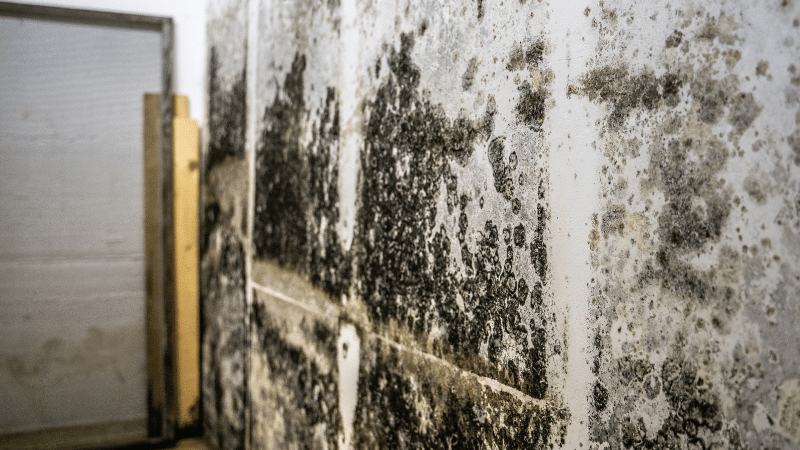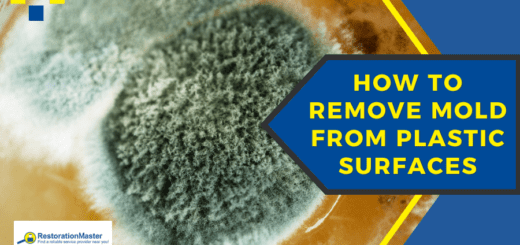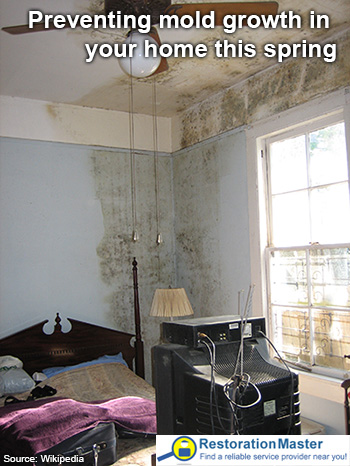Got mold? Steps to cleaning up mold after a flood
After a heavy rain, the lower level of your home may experience some minor floodingFlooding is the overflow or accumulation of water in areas t... More. In many cases, this will mean nothing more than a few puddles you can take care of with a mop and a box fan. Even when floodingFlooding is the overflow or accumulation of water in areas t... More is minimal, however, your home is still at risk of developing moldMold is a type of fungus that grows in damp or humid conditi... More, and moldMold is a type of fungus that grows in damp or humid conditi... More can be harmful to your health because it produces allergens.
The best way to deal with moldMold is a type of fungus that grows in damp or humid conditi... More is to consult a professional cleaning and restorationRestoration is the process of returning a property to its pr... More company. This can be expensive, though; so, we’ve compiled a basic list of mold removal tips to help your family stay safe and to help you save money.
How to determine if your house has mold
If your home has taken on water, chances are very high that it will develop moldMold is a type of fungus that grows in damp or humid conditi... More, and so it’s best to take preemptive measures. Mold remediation is actually quite simple. MoldMold is a type of fungus that grows in damp or humid conditi... More is a living organism that thrives on moisture. To remove moldMold is a type of fungus that grows in damp or humid conditi... More, you must then remove moisture and prevent it from coming back.

Identify moisture source
After you have gone through and removed the majority of the floodwater from your home, chances are that you will still find a little bit of it dripping in. Common breach points include cellar windows or cracks in your basement wall, but rainwater could also be entering your home through a backed up faucet connected to your city’s water system.
Whatever the case may be, the first step to mold cleanup is to repairRepair is the act of fixing or restoring damaged property, m... More the broken part of your home that has allowed water to get in.
Use a biocide
Once you have repaired your window or caulked your wall crack, you’ll want to apply a biocide to the area that flooded. A biocide is a chemical that kills organic materialsOrganic materials are derived from living organisms, such as... More like moldMold is a type of fungus that grows in damp or humid conditi... More, and the cheapest, most effective biocide to use is bleach.
If you are working in an unfinished basement, biocide application will be extremely simple. All you’ll need to do is dilute the bleach with water as per the instructions on its bottle and then apply your solutionA solution is a homogeneous mixture of two or more substance... More to your concrete floor and walls. If, however, you’ve experienced floodingFlooding is the overflow or accumulation of water in areas t... More in a finished room with carpet and dry wall, your mold remediationMold remediation is the process of identifying, removing, an... More may become a bit more complex.
Mold Removal

Even after moldMold is a type of fungus that grows in damp or humid conditi... More has been killed with a biocide, its dead remains still contain sporesSpores are microscopic reproductive units of fungi or mold t... More that can pose health hazards. On an unfinished, concrete floor, these sporesSpores are microscopic reproductive units of fungi or mold t... More can simply be wiped away with a paper towel. In finished rooms, however, removal is not so simple. For one thing, a biocide-like bleach will permanently discolor your carpet. On top of this, carpet and drywall are porousPorous describes a material that contains small openings or ... More materials, and as such, they can harbor allergenic moldMold is a type of fungus that grows in damp or humid conditi... More sporesSpores are microscopic reproductive units of fungi or mold t... More deep within.
If you suspect that you have moldMold is a type of fungus that grows in damp or humid conditi... More underneath your carpet or behind your drywall, you should consult a professional moldMold is a type of fungus that grows in damp or humid conditi... More cleanup crew. Professionals can determine whether total replacement is necessary, and they can perform the repairs for you and handle disposal.
Treating moldMold is a type of fungus that grows in damp or humid conditi... More is for the most part common sense. Follow these basic mold removal tips, and you’ll be sure to get pretty far on your own. At some point, however, you may need to consult a qualified professional.











